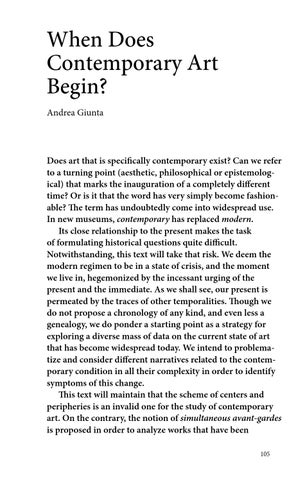When Does Contemporary Art Begin? Andrea Giunta
Does art that is specifically contemporary exist? Can we refer to a turning point (aesthetic, philosophical or epistemological) that marks the inauguration of a completely different time? Or is it that the word has very simply become fashionable? The term has undoubtedly come into widespread use. In new museums, contemporary has replaced modern. Its close relationship to the present makes the task of formulating historical questions quite difficult. Notwithstanding, this text will take that risk. We deem the modern regimen to be in a state of crisis, and the moment we live in, hegemonized by the incessant urging of the present and the immediate. As we shall see, our present is permeated by the traces of other temporalities. Though we do not propose a chronology of any kind, and even less a genealogy, we do ponder a starting point as a strategy for exploring a diverse mass of data on the current state of art that has become widespread today. We intend to problematize and consider different narratives related to the contemporary condition in all their complexity in order to identify symptoms of this change. This text will maintain that the scheme of centers and peripheries is an invalid one for the study of contemporary art. On the contrary, the notion of simultaneous Âavant-Âgardes is proposed in order to analyze works that have been 105
